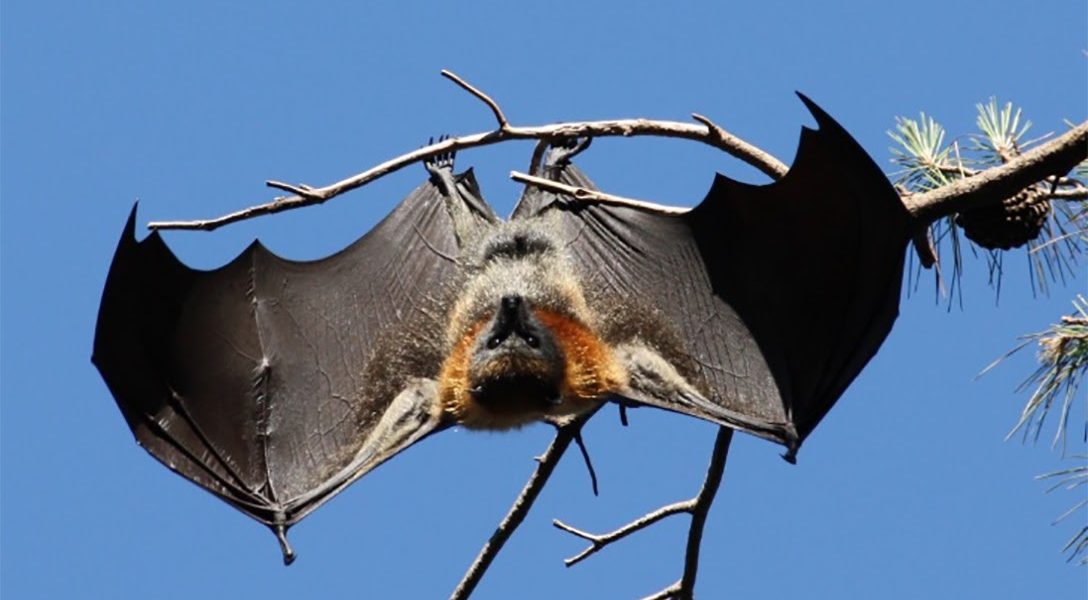Why do so many deadly viruses originate in bats?
While people across the world were celebrating the holidays with loved ones at the end of last year, somewhere in China the coronavirus pandemic began with a virus moving from bats to pigs and, ultimately, to the first human.
The rest, as they say, is history. Or at least it will be when the final chapter of the great COVID-19 pandemic of 2020 is written.
But why are bats so often behind viruses that sweep across the globe and kill so many of us?
In this week’s WhoWhatWhy podcast we talk with Cara Brook. She is a Miller postdoctoral fellow in the department of integrative biology at the University of California, Berkeley. She received her PhD from Princeton, where she conducted a pioneering field study of flying bats in Madagascar.
Along with her colleagues, Brook showed that the bats’ unusually strong immune responses to viruses actually drive an infection to greater virulence. As bat cells fight off viruses, they release interferon, which normally functions as a virus fighter. But in bats it can paradoxically lead to an increase in virulence and infectivity. This wreaks havoc when the same viruses infect animals with tamer immune systems, and are then transferred to humans.
Brook’s research explains, in grim detail, how and why some of the worst viral disease outbreaks in recent years — SARS, MERS, Ebola, Marburg, and now COVID-19 — originated in bats.



Click HERE to Download Mp3
Full Text Transcript:
As a service to our readers, we provide transcripts with our podcasts. We try to ensure that these transcripts do not include errors. However, due to time constraints, we are not always able to proofread them as closely as we would like. Should you spot any errors, we’d be grateful if you would notify us.
| Jeff Schechtman: | Welcome to the WhoWhatWhy podcast. I’m your host, Jeff Schechtman. It’s amazing how many times in the past few weeks I’ve read, “How did we get here?” Sometimes that refers to the public health and political response to the Coronavirus, but it also sometimes refers to how it all began. 90 days ago we were with friends and family celebrating the holiday season. Today, a global pandemic has shaken the world to its very core. The answer simply stated is that it all started with bats. Before pigs, before the wet markets in Wuhan, the evolution of bats might be referred to as patient zero. |
| Jeff Schechtman: | If this seems hard to believe or to understand, my guest, UC Berkeley researcher Cara Brook is here to explain. Cara Brook is a postdoctoral fellow with UC Berkeley’s Miller Institute for Basic Research. Her research focuses on understanding the role that bats play as reservoirs for highly virulent emerging diseases, including rabies and viruses. Cara is a graduate of Stanford and Princeton, and it is my pleasure to welcome Dr. Cara Brook to the WhoWhatWhy podcast. Cara, thanks so much for joining us. |
| Cara Brook: | Oh, thanks. It’s a pleasure to be here. |
| Jeff Schechtman: | As we look at this and past pandemics, things like SARS and Ebola, so much of it could be traced back to bats. Talk about that first. |
| Cara Brook: | Yeah, so bats as reservoirs for virulent viruses is, as you said, the focus of my research, and we, a graduate student and I and my group last year published a paper where we actually were able to demonstrate that bat borne zoonotic viruses, zoonotic means passing from an animal reservoir to a human host, and that bat borne zoonoses are the most virulent of all mammalian zoonoses. So meaning they cause the highest base fatality rates upon emergence into the human population. |
| Cara Brook: | We think that the reason for this is related to the evolution of flight. So, bats are the only flying mammal and flight as a physiological process is more metabolically expensive than any form of terrestrial locomotion, so a human at full speed running will raise their baseline metabolic rate two or threefold. A rodent will raise their metabolic rate up to seven fold, but a bat in flight will elevate its BMR, basal metabolic rate up to 15 fold when flying. And typically we expect the bat metabolic activity trades off with longevity. So species that have really high metabolic rates tend to be much shorter lived. Rodents are a perfect example of that. |
| Cara Brook: | But sort of flying in the face of that prediction, bats are the longest lived for their body size of any mammalian taxon. So the longest living bat that’s ever been recorded, the Brant bat, has been found to live up to 40 years in the wild, and a rodent of the same size, it’s only a couple of grams, would live up to two years at most. So what we think is going on is that bats, in order for flight to even have become evolutionarily possible to begin with, bats needed to evolve hyper-efficient cellular mechanisms by which to reduce the oxidative stress that’s encouraged from the general process of metabolism. |
| Cara Brook: | So metabolism accrues oxygen free radicals as a byproduct, which then get oxidized and the damage gets mitigated and repaired by cellular functioning. But when that damage accumulates and outpaces the body’s ability to reduce it, that’s what we call oxidative stress. And generally over time, the accumulation of oxidative stressors leads to senescence. So, leads to the inability of our tissues and organs to continue functioning, and that’s what we now think of as aging. So bats it seems as a mechanism to support their ability to fly, which is so metabolically expensive, have evolved these really efficient DNA damage and repair pathways and oxidative stress mitigation pathways at the cellular level that enable them to withstand this highly physiologically expensive activity. Then as a consequence of that, bats have evolved this extraordinary longevity because their cells are so resilient to these stressors. |
| Cara Brook: | More recently we’ve started to think that this also might play a role in their resilience to viral infection. So viruses in a cell will cause oxidative damage directly to that cell. And then in addition, a viral infection will lead to the recruitment of immune cells to the site of that infection causing widespread inflammation, and that is also an oxidative stressor. So it seems that because of flight bats have evolved these efficient pathways to mitigate that damage, but then that’s also allowed them to be long lived and to be really resilient to virus so they can host these viruses, such as Ebola, or Marburg, or SARS, or MERS without actually experiencing disease, without getting sick. |
| Jeff Schechtman: | If we can, let’s back up a little bit and talk about how the bats could infect other mammals even before they get to humans, and how that transfer then to humans takes place. |
| Cara Brook: | Yeah, so typically in disease ecology, which is my field, we do a lot of epidemiological modeling, and when we model the process of transmission, so passing a pathogen such as a virus from one host to another, we estimate this transmission rate, which we usually use the Greek letter beta to describe. Encapsulated in that transmission rate, beta is both the infectiousness of the first host that’s passing the infection, the susceptibility of the host that’s receiving the infection, then the contact rates between them. So any of those three components of beta modulating any of those three is going to affect the probability of transmission taking place. |
| Cara Brook: | So with respect to infectiousness, research is suggesting that there’s a certain seasonality to that infectiousness. They appear to shed more virus during periods in which they are immunocompromised or otherwise physiologically stressed. So during the reproductive period and then also during nutritionally dry periods, many of these infections come from fruit bats. So there’s a distinctive seasonality to the fruit availability in the country that these bats … whichever viral emergence you happen to be focusing on. So, that’s infectiousness. |
| Cara Brook: | Susceptibility is going to vary by host to host. There might be seasonal factors related to that as well. There might also be certain individuals are more immune-compromised. Then also we’ve discovered that there’s an inverse correlation between biogenetic distance between two hosts and the probability of zoonosis. So it seems that viruses that have evolved for a long time in a bat are more likely to transmit to an organism that is closely related to a bat. So bats and humans are quite phylogenetically distant from one another, so they are both still mammals, but they’re about as far apart mammalian orders as you could find. So often what we see in this transmission process is that viruses will first spill over from bats to what we call an intermediate host or a secondary host. |
| Cara Brook: | In the case of SARS, that was a civet cat. In the case of MERS, that was a camel. In the case of Ebola and Marburg, we sometimes see nonhuman primates. In the case of Hendra and Nipah, Henipaviruses, Hendra is horses, Nipah it’s pigs, and then from that organism to a human. So that acts as sort of a secondary bridge host that bridges that phylogenetic distance between the bat and the human. |
| Cara Brook: | There are some bat borne pathogens that can spill over directly, Nipah virus for instance in Bangladesh will spill over directly every year from bat to human. But they’re sort of interesting, unique transmission pathways that enable that bat could host jump. So in the case of Nipah virus in Bangladesh, the viruses shed in bat urine. And in Malaysia we saw Nipah emerge first through a pig host. So it went from a bat where they shed virus in their urine, it landed in pig paddocks, pigs obtain the virus, and then [inaudible] workers became infected from handling the pigs. |
| Cara Brook: | But in the case of Bangladesh, people actually consume date palm sap, there and bats roost in these date palms. So when viruses shed in that urine into the sap and collected in these vessels that people use to collect sap for drinking, that can be infected with virus and get this very high dose that is able to make that evolutionary jump. So a place like the wet markets that we see in southern and central China bring together a lot of these organisms that are not typically found in close proximity. That brings us to that third component of beta, the transmission term, that contact rate. |
| Cara Brook: | So, something like a wet market is going to really increase the contact rates between distantly related hosts and make the probability of emergence between them much more likely. So in the case of SARS-Covid-2, which is the virus that causes Covid-19, we’ve not yet categorically demonstrated a clear secondary host. There’s been some discussion of pangolins, some discussion of pigs, but no clear evidence whether there was a secondary host, and if so, what that host might’ve been. But you can imagine that bringing live bats in captivity in close proximity to something like a pig, or something like a pangolin that they might otherwise not encounter in the wild, is going to greatly facilitate the probability of a virus transmitting from one host to another and then onto the human. |
| Jeff Schechtman: | Once it transfers to humans, talk a little bit about how those characteristics of the bat relate to humans and the way the human immune system responds to it almost in overdrive, which is part of what’s killing people right now. |
| Cara Brook: | Yeah, so because bats are so resilient to viral infection, this hypothesis related to flight, I’ve done some work both in cell culture and also some theoretical modeling work that suggests that viruses evolved different evolutionary optimums. So typically we think that viruses will evolve to balance their rates of transmission and the virulence incurred on their host, virulence being damage to the host, so what we think of as disease. So typically a virus is not going to want to hurt its host, because a virus’s evolutionary goal is to transmit to as many new hosts as possible to maximize its rate of between host transmission. We refer to that as R Naught, that basic reproduction number for a pathogen, and R0 is both the compilation of the number of new transmissions divided by the loss of transmissions through the loss of infected hosts. |
| Cara Brook: | That can take place through a host recovering from infection or also from dying. So if the virus replicates very fast, it might improve its ability to transmit to new hosts, but at the same time it might be killing its first host much more quickly, and there’s a trade-off between those two where at some point, even though it’s replicating fast, reaching high viral loads that are likely to infect others, that host is going to be dying too quickly for the pathogen to be able to spread any more quickly than it was before, so we call that its optimal virulence when it’s balanced, that equation, and maximized its R0. And in the case of bats, since they are so resilient to these viral infections, we think that essentially the optimal R0 for this pathogen involves a very high within host rate of virus spread, because that viral replication in the bat host is not actually damaging the bat. |
| Cara Brook: | So the virus, this sort of evolutionary ceiling on that trade-off is lifted, and a virus can evolve to either replicate or overcome host defenses much more quickly to enable it to reach higher viral loads in its host, and when that emerges into a host that is not a bat, we expect that that would cause extreme pathology because our immune systems are not as equipped to deal with those infections as others. |
| Cara Brook: | So one good example of that is that several species of Old World fruit bat have been demonstrated to have constitutively expressed interferon alpha. Interferon is an antiviral cytokine, which is a signaling protein. And typically what happens when a virus invades a cell, the viral RNA in that cell, the cell perceives that the virus has infected it and secretes interferon to initiate this downstream signaling cascade that alerts neighboring cells to the presence of infection and induces this antiviral state where those neighboring cells secrete a series of host factors and basically go into lock down and trap the infection from spreading any more quickly. |
| Cara Brook: | So in a human host, we couldn’t have a conclusively expressed antiviral response because it would induce widespread inflammation, but we think that bats, due to their evolutionary adaptations related to flight, are able to sustain these otherwise inflammatory pathways. So we can imagine that if the virus co-evolved with a bat host that has these really robust antiviral immune defenses, it’s going to evolve ways to circumvent those processes and still maintain infection within that host. But then when it emerges into something like a human that lacks those pathways, it ends up being too virulent and showing maladaptive virulence and killing that host much faster. |
| Cara Brook: | What I should say is that in the case of this SARS-CoV-2 that causes Covid-19, this virus actually is very well adapted to its human host. It’s not as virulent as SARS or MERS for example, both of which had higher case fatality rates than the human host but were much less transmissible. So in the case of this virus, we think that we’ve seen a bit of evolution in the human host that now means that this virus is well equipped to spread from human to human without killing those people too quickly before it achieves a new infection. |
| Jeff Schechtman: | To what extent can understanding all of this help us in the treatment of the virus? |
| Cara Brook: | Yeah, it would be difficult to try to induce the same sort of immune responses that we see in bats in human hosts. As I mentioned, we’re not equipped to sustain that kind of inflammation, so it’s not really an effective pathway for therapeutics. But understanding the transmission dynamics and the reservoir host is absolutely essential to avoiding these spillover events in the future. |
| Jeff Schechtman: | One of the things that also goes on is what’s going on with bats today and the loss of habitat throughout the world and the impact that that’s having. |
| Cara Brook: | Yeah, so as I mentioned, transmission from a bat host to a human or to a secondary host is dependent on this term beta that involves both infectiousness, susceptibility, and these rates of contact. When we encroach on wild habitat where these animals live, we’re overburdening that contact rate and making it much more likely that we are going to encounter pathogens that we would not otherwise. The same goes for our domestic wildlife, such as pigs that are often these secondary amplifying hosts. |
| Cara Brook: | At the same time, our work … I’m part of a collaborative network called BatOneHealth. We work in Australia studying Hendra virus, in Bangladesh studying Nipah virus, and then in Madagascar and Ghana studying bat borne Henipaviruses in the same family. What we’ve been able to demonstrate is that bats in intact habitats under good nutritional condition actually shed less virus in their urine during these annual pulses that take place during the nutritionally poor periods of the year. So bats that are in better conditions pose less of a zoonotic threat. So increased anthropogenic impacts on wild animal habitat elevate the stress levels in these wild organisms, and then also compromise their immunity, which can lead both to heightened contact rates between bats and human hosts and to heightened infectiousness in the bat host through the process of viral shedding. |
| Jeff Schechtman: | Tell us a little bit about where this research is going on right now, and who are the people that are funding and responsible for it. |
| Cara Brook: | So as I mentioned, our BatOneHealth team works in four global field sites. My work is focused in Madagascar. I studied three species of endemic Old World fruit bat on the Island of Madagascar and worked very closely with Institut Pasteur of Madagascar, and in particular a Malagasy biologist, [inaudible 00:19:09]. The field team in Australia is led by Dr. Raina Plowright of Montana State University, Dr. Ali Peel of Griffith University in Australia, and a number of hardworking graduate students and post docs who work with them. There’s a team that is joined with John Hopkins University and led by Dr Emily [inaudible] that works in Bangladesh. Then our team in Ghana involves a number of Ghanaian scientists joint with the team at Cambridge University as well. |
| Jeff Schechtman: | To what extent can all of this be anticipated looking forward that we are going to see future pandemics, not unlike this, also emanating from bat. |
| Cara Brook: | I think that bats certainly serve as a source of highly virulent, dangerous pathogens and the more impacts on wild fruit bats and insectivorous bat habitat that we’re going to see into the future are going to be paired with future zoonosis. I mean, already in the past 20 years, we’ve seen outbreaks of SARS and MERS and now SARS-CoV-2 Coronaviruses. In addition, Ebola and Marburg, filoviruses, Hendra and Nipah Henipaviruses, where we see human cases every year. |
| Cara Brook: | So this is a recurring problem and zoonotic pathogens pose some of the greatest threats because we are not able to control the infection through human public health. The Black Death was so globally destructive because a lot of the public health measures that were taking to combat Covid-19 were ineffective because there was a rodent reservoir for that pathogen. So regardless of how we vaccinate or control a pathogen within the human population, if it has a zoonotic source, it’s going to become a recurring threat. |
| Cara Brook: | And in the case of Coronaviruses, they’re highly, highly diverse in bat populations globally and several have demonstrated their ability to enter human cells, to bind this human cell receptor ACE2 and become infectious in the human population. So I think that it’s really important that we be aware of the potential threats posed by these bat populations, but also understand that processes and patterns of exploitation actually exacerbate this problem, and that by working together with conservation biologists and public health practitioners, we can achieve win-wins for both wildlife conservation and human public health. |
| Jeff Schechtman: | What is the cutting edge of the research right now? What is it that you and your colleagues are still trying to uncover and understand about these processes that we’ve been talking about? |
| Cara Brook: | Bat immunology is a very young and up and coming field. I mentioned some of the pathways, interferon was one, but there’s a number of unique host virus specific evolutionary adaptations taken by different bat species with respect to different viruses. Also, to an extent, we sort of off the cuff tend to say that bats don’t get sick from these viral infections, but in most cases of reservoir hosts we’ve eventually been able to demonstrate that there is some sort of pathology. |
| Cara Brook: | So, a great example is SIV, simian immunodeficiency virus, which infects chimpanzees for a number of years, it was cited in the scientific literature that SIV was totally non-pathogenic but took a 40 year dataset coming out of Jane Goodall’s work to demonstrate that there actually are more survival effects on the offspring of infected mothers. So demonstrating fitness affects of these pathogens on the bat hosts, understanding exactly how they cope with them and what the sort of trade-offs are might give us an opportunity to understand if any of these unique bat defenses are something that could be leveraged for something like immunotherapy in a human. |
| Jeff Schechtman: | Cara Brook, I thank you much for spending time with us today. |
| Cara Brook: | Yeah. Thanks, it was a pleasure. |
| Jeff Schechtman: | Thank you. And thank you for listening and for joining us here on radio WhoWhatWhy. I hope you join us next week for another radio WhoWhatWhy podcast. I’m Jeff Schechtman. If you liked this podcast, please feel free to share and help others find it by rating and reviewing it on iTunes. You can also support this podcast and all the work we do by going to WhoWhatWhy.org/donate. |
Related front page panorama photo credit: Adapted by WhoWhatWhy from David Darricau / Flickr (CC BY-NC-SA 2.0) and Princeton.



